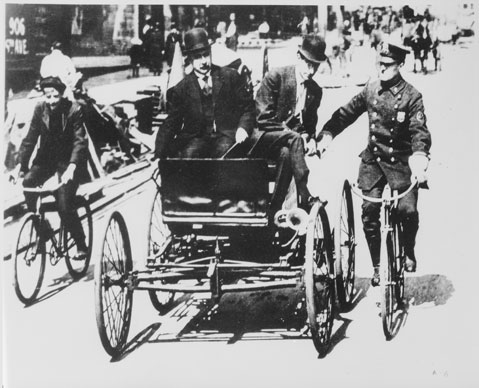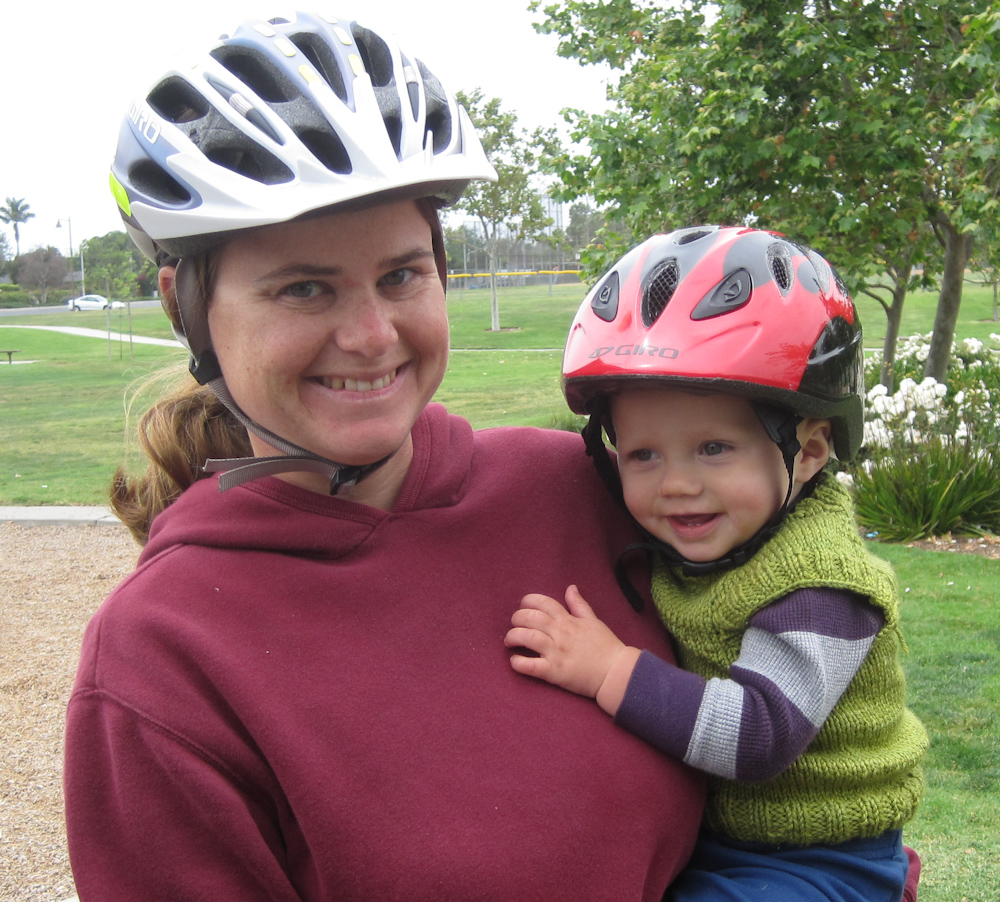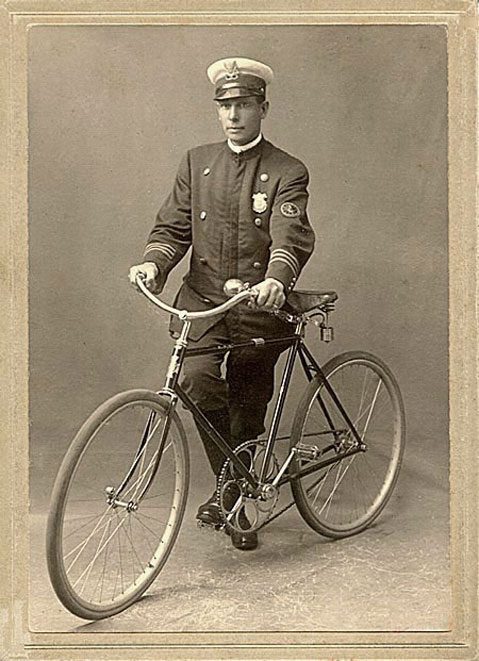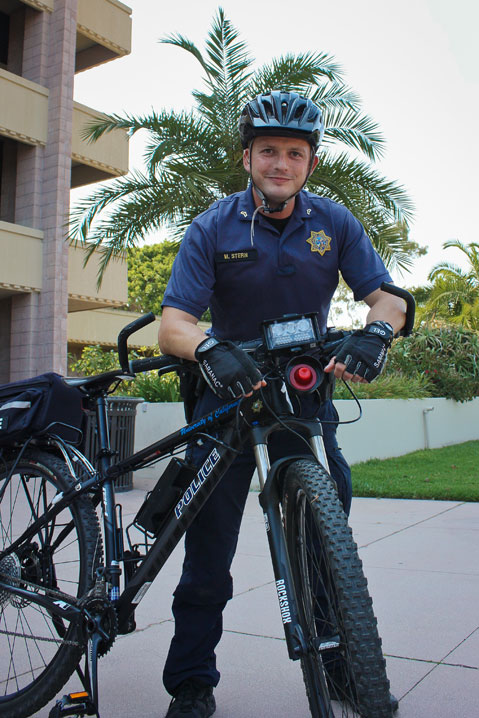Wheeled Patrol
Police on Bikes Gain Stealth, Agility, Approachability

President Theodore Roosevelt brought national attention to bicycle police when he was pulled over by two officers on bikes in June 1905. Roosevelt’s chauffeur had exceeded the 15 mile per hour speed limit and was pursued and pulled over by the quick-cycling officers. The driver was allowed to proceed when the officers realized that they had just stopped and nearly cited the President who, for his part, instructed his chauffeur to slow down.

Ironically, the president was a bicyclist and was an early champion for bike patrols. At his post as police commissioner, a decade earlier, he had approved a 29-man squad to help patrol the streets of New York City. The squad was a great success, though it would be some time before cars replaced carriages as speeding suspects.
Scorchers and Slingshots
At the time of their inception in the late 1800s, bike patrols were mainly used to catch runaway horses and “scorchers,” as speeding cyclists were sometimes known. The bicycle-mounted police proved to be a more efficient and kinder solution to the “scorcher” problem than a tactic rumored to be used by Chicago police at the time: using slingshots to fire lead balls into wheel spokes — halting riders in a hurry.

Given limited technology, bicycles may have seemed an obvious choice for late-19th-century police officers. Technology has come a long way from slingshots and antique bikes. Modern day squad cars can travel over 100 miles an hour, so why trade one in for a bicycle? I spoke with Corporal Matt Stern of UCSB Police Department’s bicycle patrol program to find out.
Making Contact
Marked police cars are a great crime deterrent. They encourage drivers to ease off the accelerator, pedestrians to seek out crosswalks, and criminals to think twice about the potential repercussions of their actions. But they’re also imposing and formidable. It’s hard to see past the lights, armor, and windshield glare of a squad car to find a person inside. Bikes can help bridge the gap that sometimes occurs between the public and law enforcement officials. Stern says, “By being more approachable and by not being stuck in a patrol car, bicycle patrols help break down certain stigmas and negative perceptions some have about law enforcement officers.”
An officer on bike is less removed from the public and instantly more personable. Corporal Stern enjoys biking while on shift for precisely this reason: “It’s much easier to interact and establish relationships with community members.” In the 10 minutes it took for him to pedal across the UCSB campus, he stopped twice for people approaching to ask directions. Stern goes on, “I make a lot more contacts with the community and have more opportunities to establish a good relationship with the people I serve.”
Stealth
Bike patrols are not all about public relations; they also provide excellent strategic advantage in certain situations. Officers on bikes are quieter and less obtrusive than those in cars, making it more likely that they will notice a crime in progress before the suspect notices them.
Bikes allow officers to slow down when observation is necessary, or cover ground briskly when speed is needed. Stern says, “An officer can move quickly through a crowd while on a bike, and can find short cuts … where a patrol car would have very diminished mobility in the same situation.”
Moving rapidly and efficiently is particularly useful in areas with heavy traffic congestion where a patrol car might be boxed in. At UCSB large sections of campus are inaccessible by car, but perfectly suited to biking.
Not Just the President
Modern bicycle-mounted police can, and do, pull over motorists. Being limited in size and speed would seem a major disadvantage in pulling over vehicles; however, today’s police bikes are loaded with features to make them fast, maneuverable, and highly visible. The LED lights mounted on Corporal Stern’s bike are visible from up to a quarter mile away, and the bike’s siren blasts at 120 decibels.

Police traveling by bicycle also have greater perception of what’s happening around them. They can hear and see things that drivers cannot. The higher vantage point of cyclists allows them to see into vehicles more clearly. Stern says this vantage point is particularly useful in stopping distracted drivers, “Bicycles are a great way to stop vehicles in violation of California cell phone and seat belt laws which can be difficult to spot while in a moving patrol car.”
Cutting Costs
The financial costs of outfitting and maintaining a bicycle are substantially less than a squad car, and the environmental effects are also significant. According to LAPD Online, the Los Angeles Police Department anticipates that its use of bicycles for police work will, “generate a reduction of over 1.5 million vehicle miles traveled.”
Of course, bikes cannot completely replace police cars. Vehicles are needed for high-speed chases, for holding and transporting suspects, and for inclement weather. But, increasing the number of police bikes can help to lower operation expenses, curb greenhouse gas emissions, and reduce traffic congestion.
Pedaling into the Future
Biking not only benefits the public, it benefits the officers as well. Stern says, “Patrolling by bicycle is an excellent way to stay in shape, is good for morale, adds a little challenge to the officer’s day, and can be a really enjoyable experience.”
Bike patrols help to create safer communities, happier officers, and a healthier environment. They are a part of police history that we should strive to maintain.


